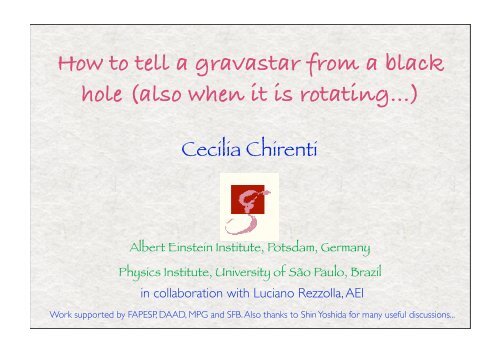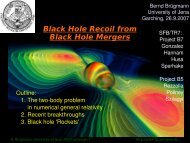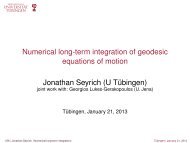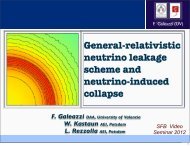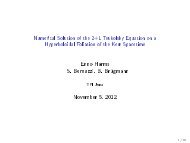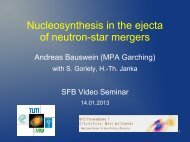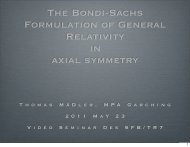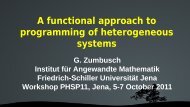How to tell a gravastar from a black hole (also when it is rotating...)
How to tell a gravastar from a black hole (also when it is rotating...)
How to tell a gravastar from a black hole (also when it is rotating...)
- No tags were found...
Create successful ePaper yourself
Turn your PDF publications into a flip-book with our unique Google optimized e-Paper software.
Axial-Perturbations analys<strong>is</strong>We use a “triangular grid”,i.e a purely outgoing nullslicing, and evolve theperturbation equation afterintroducing an in<strong>it</strong>ialGaussian pulse. Thesolutionψ<strong>is</strong> extracted at alarge d<strong>is</strong>tance and after thein<strong>it</strong>ial transient has died off.
Rotating <strong>gravastar</strong>sIn a recent work (Cardoso et al, 2007), a generalization of the originalstatic, spherically symmetric <strong>gravastar</strong> model was considered, in order<strong>to</strong> describe <strong>rotating</strong> <strong>gravastar</strong>s.A slow rotation approximation was used <strong>to</strong> describe the axiallysymmetric spacetime of a <strong>rotating</strong> <strong>gravastar</strong>. It was argued that<strong>gravastar</strong>s might be unstable due <strong>to</strong> the ergoregion instabil<strong>it</strong>y.The preliminary results obtained by Cardoso et al indicate that thetime scale of the instabil<strong>it</strong>y could be very short <strong>when</strong> compared <strong>to</strong>the Hubble time. Further investigation <strong>is</strong> still needed...
Rotating <strong>gravastar</strong>sds 2 = −e ν(r) dt 2 + e λ(r) dr 2 + r 2 dθ 2 + r 2 sin 2 θ (dφ − ω(r)dt) 2ω(r) gives the dragging of the inertial frameAn<strong>is</strong>otropic energy momentum tensorT µν = (ρ + p t )u µ u ν + p t g µν + (p r − p t )s µ s νΩSlow rotation approximation (<strong>to</strong> first order in )u µ u µ = −1 , s µ s µ = 1 , u µ s µ = 0 ,u r = u θ = 0 , u φ = Ωu t ,u t = [ −(g tt + 2Ωg tφ + Ω 2 g φφ ) ] −1/2Ω <strong>is</strong> the angular veloc<strong>it</strong>yof the <strong>gravastar</strong>
Ergoregion instabil<strong>it</strong>y: effective potentialsfor a scalar field in thebackground metric, thereare the two rotationallyspl<strong>it</strong> “effective potentials”V + and V − .ψ ,rr + m 2 T (r, Σ)ψ = 0 ,T = e λ−ν (Σ − V + )(Σ − V − ) ,V ± = −ω ± e ν 2rΣ = σ m
Size of the ergoregionThe size of the ergoregion increases w<strong>it</strong>h both the compactness andthe thickness of the shell. But there are constrains...
Where <strong>is</strong> an ergoregion possible?We have already d<strong>is</strong>cussed the spaceof possible solutions in the (µ, δ) planefor spherical g*’sTh<strong>is</strong> space<strong>is</strong> furtherdivided ifrotation <strong>is</strong>taken in<strong>to</strong>accountno ergoregion
Where <strong>is</strong> an ergoregion possible?For a given pointin the (µ, δ)plane <strong>it</strong> <strong>is</strong>possible <strong>to</strong>determine thecr<strong>it</strong>ical angularveloc<strong>it</strong>y abovewhich anergoregion <strong>is</strong>present.G*’s w<strong>it</strong>h angular veloc<strong>it</strong>ies smaller than the cr<strong>it</strong>ical one do nothave an ergoregion and are therefore expected <strong>to</strong> be stable.WKB analys<strong>is</strong> or calculation of eigenfrequencies will then establ<strong>is</strong>hwhether unstable g*’s are so in a Hubble time...
Conclusionso g*’s are an ingenious solution of the Einstein eqs: can be arb<strong>it</strong>rarily compact, w<strong>it</strong>houter surface just outside the horizon of BH of same masso Still unclear processes leading <strong>to</strong> formation of g*’s and if they ex<strong>is</strong>t at all. If ex<strong>is</strong>t,heat capac<strong>it</strong>y of the surface high enough <strong>to</strong> avoid heating and <strong>black</strong>-body em<strong>is</strong>siono We have constructed a simple but general class of g*’s w<strong>it</strong>h the basic features ofthe thin-shell model but allows for a stabil<strong>it</strong>y analys<strong>is</strong>.o Two basic questions have two basic answers: g*’s are stable (axial perturbations):can be d<strong>is</strong>cerned <strong>from</strong> a BH through the em<strong>is</strong>sion of GWs via QNM oscillationso Rotating g*’s could be subject <strong>to</strong> an “ergoregion instabil<strong>it</strong>y” (Cardoso et al. 2007). Sofar, found the space of parameters that allows the ex<strong>is</strong>tence of an ergoregion.o Interesting new result: an ergoregion <strong>is</strong> not present for all g*’s and hence some<strong>rotating</strong> g*’s could be ergoregion-stable.o Future work: compute eigenfrequencies of unstable g*’s and assess if instabil<strong>it</strong>yoccurs on timescales shorter than Hubble time.
Where <strong>is</strong> an ergoregion possible?We have already d<strong>is</strong>cussed the spaceof possible solutions in the (µ, δ) planefor spherical g*’sTh<strong>is</strong> space<strong>is</strong> furtherdivided ifrotation <strong>is</strong>taken in<strong>to</strong>accountno ergoregion


